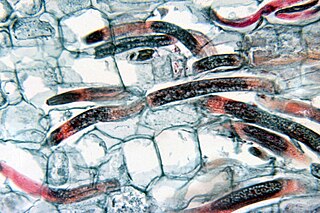Related Research Articles

Radopholus similis is a species of nematode known commonly as the burrowing nematode. It is a parasite of plants, and it is a pest of many agricultural crops. It is an especially important pest of bananas and citrus, and it can be found on coconut, avocado, coffee, sugarcane, other grasses, and ornamentals. It is a migratory endoparasite of roots, causing lesions that form cankers. Infected plants experience malnutrition.
The pterobranchia mitochondrial code is a genetic code used by the mitochondrial genome of Rhabdopleura compacta (Pterobranchia). The Pterobranchia are one of the two groups in the Hemichordata which together with the Echinodermata and Chordata form the three major lineages of deuterostomes. AUA translates to isoleucine in Rhabdopleura as it does in the Echinodermata and Enteropneusta while AUA encodes methionine in the Chordata. The assignment of AGG to lysine is not found elsewhere in deuterostome mitochondria but it occurs in some taxa of Arthropoda. This code shares with many other mitochondrial codes the reassignment of the UGA STOP to tryptophan, and AGG and AGA to an amino acid other than arginine. The initiation codons in Rhabdopleura compacta are ATG and GTG.
The yeast mitochondrial code is a genetic code used by the mitochondrial genome of yeasts, notably Saccharomyces cerevisiae, Candida glabrata, Hansenula saturnus, and Kluyveromyces thermotolerans.
The invertebrate mitochondrial code is a genetic code used by the mitochondrial genome of invertebrates.
The ciliate, dasycladacean and Hexamita nuclear code is a genetic code used by certain ciliate, dasycladacean and Hexamita species.
The echinoderm and flatworm mitochondrial code is a genetic code used by the mitochondria of certain echinoderm and flatworm species.
The alternative yeast nuclear code is a genetic code found in certain yeasts. However, other yeast, including Saccharomyces cerevisiae, Candida azyma, Candida diversa, Candida magnoliae, Candida rugopelliculosa, Yarrowia lipolytica, and Zygoascus hellenicus, definitely use the standard (nuclear) code.
The candidate division SR1 and gracilibacteria code is used in two groups of uncultivated bacteria found in marine and fresh-water environments and in the intestines and oral cavities of mammals among others. The difference to the standard and the bacterial code is that UGA represents an additional glycine codon and does not code for termination.
The ascidian mitochondrial code is a genetic code found in the mitochondria of Ascidia.
Radopholus arabocoffeae is a nematode in the genus Radopholus. It is notable as an early example, along with Radopholus similis, of the alternative flatworm mitochondrial code.
The Blepharisma nuclear code is a genetic code found in the nuclei of Blepharisma.
The chlorophycean mitochondrial code is a genetic code found in the mitochondria of Chlorophyceae.
The trematode mitochondrial code is a genetic code found in the mitochondria of Trematoda.
The scenedesmus obliquus mitochondrial code is a genetic code found in the mitochondria of Scenedesmus obliquus.
The Thraustochytrium mitochondrial code is a genetic code found in the mitochondria of labyrinthulid Thraustochytrium aureum. The mitochondrial genome was sequenced by the Organelle Genome Megasequencing Program.
The pachysolen tannophilus nuclear code is a genetic code found in the ascomycete fungus Pachysolen tannophilus.
The karyorelictid nuclear code is a genetic code used by the nuclear genome of the Karyorelictea ciliate Parduczia sp.
The Condylostoma nuclear code is a genetic code used by the nuclear genome of the heterotrich ciliate Condylostoma magnum.
The Mesodinium nuclear code is a genetic code used by the nuclear genome of the ciliates Mesodinium and Myrionecta.
The Cephalodiscidae mitochondrial code is a genetic code used by the mitochondrial genome of Cephalodiscidae (Pterobranchia). The Pterobranchia are one of the two groups in the Hemichordata which together with the Echinodermata and Chordata form the major clades of deuterostomes.
References
This article incorporates text from the United States National Library of Medicine, which is in the public domain. [4]
- ↑ Telford MJ, Herniou EA, Russell RB, Littlewood DT (October 2000). "Changes in mitochondrial genetic codes as phylogenetic characters: two examples from the flatworms". Proceedings of the National Academy of Sciences USA. 10. 97 (21): 11359–64. Bibcode:2000PNAS...9711359T. doi: 10.1073/pnas.97.21.11359 . PMC 17205 . PMID 11027335.
- ↑ Joachim EM Jacob; Bartel Vanholme; Thomas Van Leeuwen & Godelieve Gheysen (2009). "A unique genetic code change in the mitochondrial genome of the parasitic nematode Radopholus similis". BMC Res Notes. 2: 192. doi:10.1186/1756-0500-2-192. PMC 2761399 . PMID 19778425.
- ↑ "Taxonomy browser (Radopholus arabocoffeae)".
- ↑ Elzanowski A, Ostell J, Leipe D, Soussov V. "The Genetic Codes". Taxonomy browser. National Center for Biotechnology Information (NCBI), U.S. National Library of Medicine. Retrieved 1 July 2016.